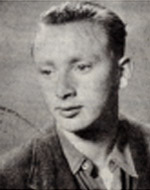Kalman, son of Chaya and Chaim-Shmuel, was born on September 2, 1927 in Poland, in the town of Zwirice in Upper Silesia, where his father was a teacher in Talmud Torah and was known for his generosity and willingness to help anyone who came to him Kalman’s father died at the beginning of World War II, and Zwircsa was among the first cities occupied by the Nazis and annexed to the German Reich at the beginning of World War II, September 1939.) Due to its location, in an area rich in natural resources and mines, Poland’s heavy industry was situated, the Germans began to take control of the large factories even before the occupation was completed, and the Jews of the region were exploited In 1942. In August 1942, the Jews of the city were rounded up in a ghetto surrounded by barbed wire, and the able-bodied young men were sent to forced labor camps in Germany, and in August 1942 an Aktion was carried out and 2,000 people were deported to Auschwitz. In Upper Silesia, the last Jews in the area, about 30,000, were sent to Auschwitz, where the Jewish community of Zwiercza was exterminated, and Kalman managed to survive in Auschwitz alone. His mother and four brothers and sisters perished. Immediately after liberation, he set out on his way to Eretz Israel. He was a member of the Hashomer Hatzair movement. In 1946, he joined the “Geulim” group in Italy and was educated as part of the “Pisentura” youth village in Rome, which operated under the auspices of Youth Aliyah. On March 3, 1947, Kalman and his friends boarded the illegal immigrant ship Shabtai Luzhinsky on his way to Palestine. The ship, which was purchased by the Haganah’s Mossad Le’Aliya, left the Metaponto harbor in Italy with 665 Ma’apilim from Romania, Hungary and Poland, flying an Italian flag. Nine days later she arrived near Nitzanim beach. The Palyam fighters (Palmach naval company) began to remove the immigrants, but the stormy sea delayed the operation and the British arrived. Although the Haganah called hundreds of Jews from the area to seek refuge in the Ma’apilim and make it difficult to identify them, many succeeded in evading the British and disappearing in the surrounding towns. Some of the immigrants, however, were captured by the British and deported to Cyprus. (Later, the song “Shoshana Shoshana” was written on this ship, whose name was Shoshana.) Kalman was among the deportees to Cyprus, where he stayed for about a month and then arrived in Israel. Since then, he was educated on Kibbutz Mizra in the framework of Youth Aliyah. Shortly after his arrival Kalman joined the ranks of the Palmach’s “Negev” Brigade, the 12th Brigade of the Haganah, and was among the fighters of the Eighth Battalion (the “Southern Negev”), with whom he participated in fierce battles throughout the War of Independence. On April 20, 1949, during a search operation in the area of Beit Guvrin, Kalman was killed near the village of Dweima, twenty-one years old, and Kalman was initially considered missing, and some time later his body was found and brought to eternal rest in the Rehovot cemetery. Is the “last bastion.” The last survivor of the Holocaust is Holocaust survivors who remained the last remnant of their nuclear family (parents, brothers, sisters, sons and daughters), who had personally experienced the Holocaust in the ghettos and And / or in concentration and extermination camps and / or in hiding and hiding in territories occupied by the Nazis and / or fighting alongside members of the underground movements or partisans in the Nazi-occupied territories who immigrated to Israel during or after World War II,
